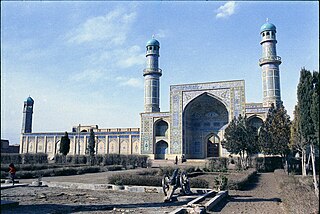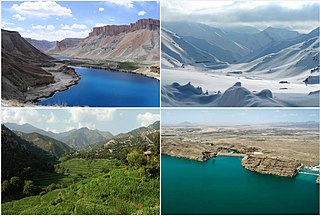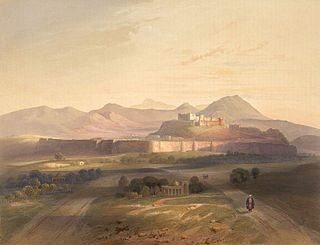
The Muslim conquests of Afghanistan began during the Muslim conquest of Persia as the Arab Muslims migrated eastwards to Khorasan, Sistan and Transoxiana. Fifteen years after the Battle of Nahāvand in 642 AD, they controlled all Sasanian domains except in Afghanistan. Fuller Islamization was not achieved until the period between 10th and 12th centuries under Ghaznavid and Ghurid dynasty's rule who patronized Muslim religious institutions.

Herāt is an oasis city and the third-largest city in Afghanistan. In 2020, it had an estimated population of 574,276, and serves as the capital of Herat Province, situated south of the Paropamisus Mountains in the fertile valley of the Hari River in the western part of the country. An ancient civilization on the Silk Road between West, Central and South Asia, it serves as a regional hub in the country's west.

Ghazni, historically known as Ghaznain (غزنين) or Ghazna (غزنه), also transliterated as Ghuznee, and anciently known as Alexandria in Opiana, is a city in southeastern Afghanistan with a population of around 190,000 people. The city is strategically located along Highway 1, which has served as the main road between Kabul and Kandahar for thousands of years. Situated on a plateau at 2,219 metres (7,280 ft) above sea level, the city is 150 kilometres (93 mi) south of Kabul and is the capital of Ghazni Province. The name Ghazni drives from the Persian word ganj ‘treasure’.

Ghazni is one of the 34 provinces of Afghanistan, located in southeastern Afghanistan. The province contains 19 districts, encompassing over a thousand villages and roughly 1.3 million people, making it the 5th most populous province. The city of Ghazni serves as the capital. It lies on the important Kabul–Kandahar Highway, and has historically functioned as an important trade center. The Ghazni Airport is located next to the city of Ghazni and provides limited domestic flights to Afghanistan's capital, Kabul.
The Ghaznavid dynasty or the Ghaznavid Empire was a Persianate Muslim dynasty and empire of Turkic mamluk origin, ruling at its greatest extent, large parts of Persia, Khorasan, and the northwest Indian subcontinent from 977 to 1186. The dynasty was founded by Sabuktigin upon his succession to the rule of Ghazna after the death of his father-in-law, Alp Tigin, who was an ex-general of the Samanid Empire from Balkh, north of the Hindu Kush in Greater Khorasan.

Abu Mansur Nasir al-Din Sabuktigin, also spelled as Sabuktagin, Sabuktakin, Sebüktegin and Sebük Tigin, was the founder of the Ghaznavid dynasty, ruling from 367 A.H/977 A.D to 387 A.H/997 A.D. In Turkic the name means beloved prince.

The Tower of David, also known as the Citadel, is an ancient citadel located near the Jaffa Gate entrance to the Old City of Jerusalem.

The Minaret of Jam is a UNESCO World Heritage Site in western Afghanistan. It is located in a remote and nearly inaccessible region of the Shahrak District, Ghor Province, next to the Hari River. The 62 m (203 ft) or 65 m (213 ft) high minaret was built around 1190 entirely of baked bricks and is famous for its intricate brick, stucco and glazed tile decoration, which consists of alternating bands of kufic and naskhi calligraphy, geometric patterns, and verses from the Qur'an. Since 2002, the minaret has remained on the list of World Heritage in Danger, under serious threat of erosion, and has not been actively preserved. In 2014, the BBC reported that the tower was in imminent danger of collapse.

The Battle of Ghazni took place in the city of Ghazni in central Afghanistan on Tuesday, July 23, 1839, during the First Anglo-Afghan War.

The 1842 retreat from Kabul was the retreat of the British and East India Company forces from Kabul during the First Anglo-Afghan War. An uprising in Kabul forced the then-commander, Major-General William Elphinstone, to fall back to the British garrison at Jalalabad. As the army and its numerous dependents and camp followers began their march, it came under attack from Afghan tribesmen. Many in the column died of exposure, frostbite or starvation, or were killed during the fighting.

The Ghuznee Medal is a British campaign medal awarded for participation in the storming of the fortress of Ghuznee in Afghanistan, on 21 to 23 July 1839 by troops of the British and Indian Armies. This action, the Battle of Ghazni, took place during the First Anglo-Afghan War.

Tourism in Afghanistan is regulated by the Ministry of Information and Culture. There are at least 350 tourism companies operating in Afghanistan. Tourism was at its peak before the 1978 Saur Revolution, which was followed by the decades of war. Between 2013 and 2016, Afghan embassies issued between 15,000 and 20,000 tourist visas annually.
The Hindu Shahis were a dynasty that held sway over the Kabulistan, Gandhara and western Punjab during the early medieval period in the Indian subcontinent, replacing the earlier Turk Shahis. They were ultimately conquered by Ghaznavid Empire in a series of wars in the early 11th century.

The Kelat-I-Ghilzie Medal is a campaign medal issued by the British East India Company, to the defenders of the fort at Kelat-I-Ghilzie during the First Anglo-Afghan War.

The Musalla complex, also known as the Musallah Complex or the Musalla of Gawhar Shah, is a former Islamic religious complex located in Herat, Afghanistan, containing examples of Timurid architecture. Much of the 15th-century complex is in ruins today, and the buildings that still stand are in need of restoration. The complex ruins consist of the five Musallah Minarets of Herat, the Mir Ali Sher Navai mausoleum, the Gawhar Shad Mausoleum, and the ruins of a large mosque and a madrasa complex.

The Ghazni offensive began on 10 August 2018, when Taliban fighters launched an assault on the city of Ghazni, Afghanistan's sixth largest city and one which has been culturally and strategically important for much of the country's history. The attack resulted in the deaths of hundreds of insurgents, soldiers, police, and civilians. The city also sustained large-scale property damage. The battle, occurring only weeks before Afghanistan's 2018 parliamentary election, was the largest since a three-day truce in June had raised hopes of peace talks.

The Ghazni Minarets are two elaborately decorated minaret towers located in Ghazni city, central Afghanistan. They were built in middle of the twelfth century and are the only surviving elements of the mosque of Bahram Shah. The two minarets are 600 meters apart and lie in an open plain, north-east of Ghazni city.

The Lawīk dynasty was the last native dynasty which ruled Ghazni prior to the Ghaznavid conquest in the present-day Afghanistan. Lawiks were originally Hindus, but later became Muslims. They were closely related to the Hindu Shahis, and after 877, ruled under the Hindu Shahi suzerainty.


























